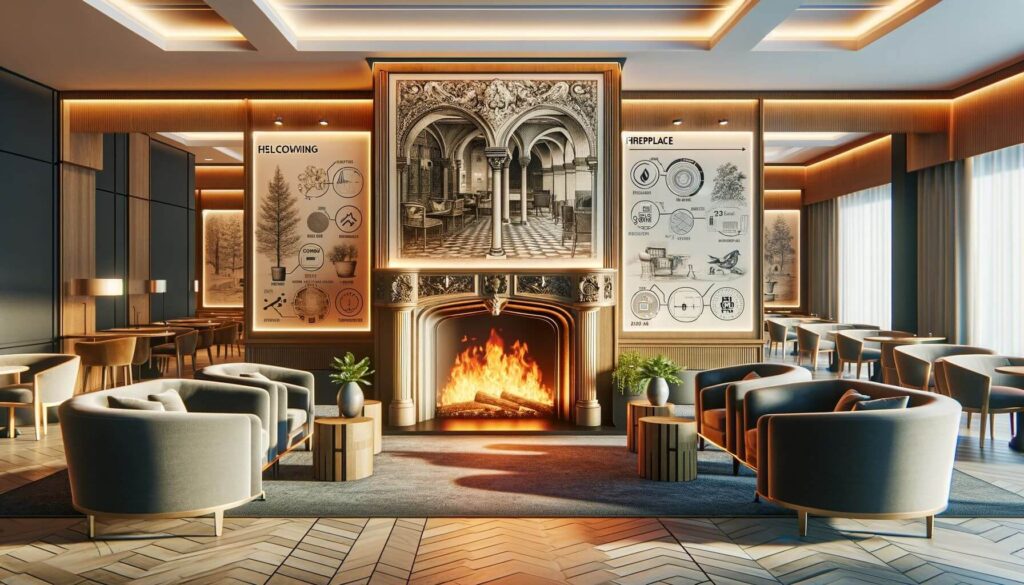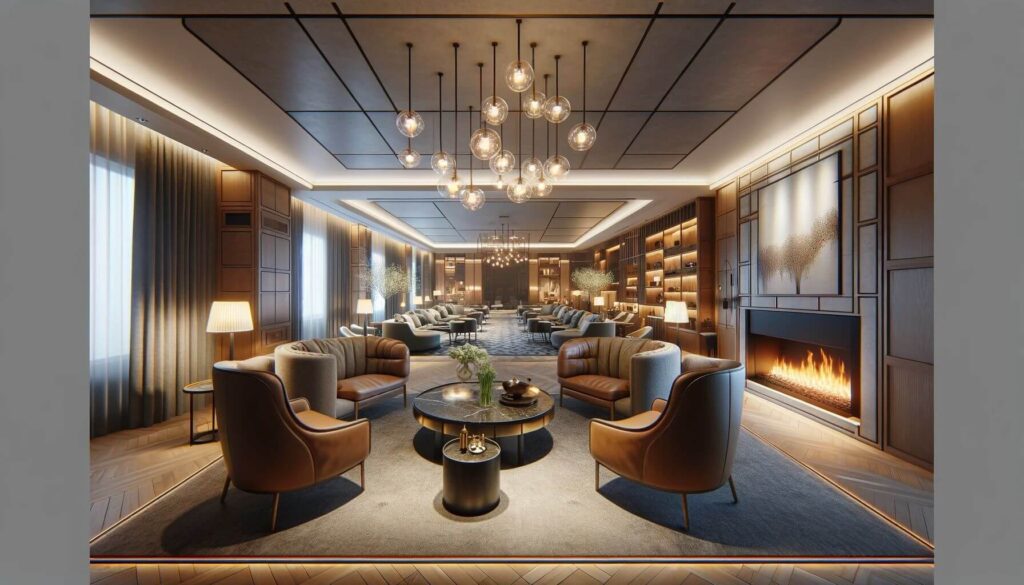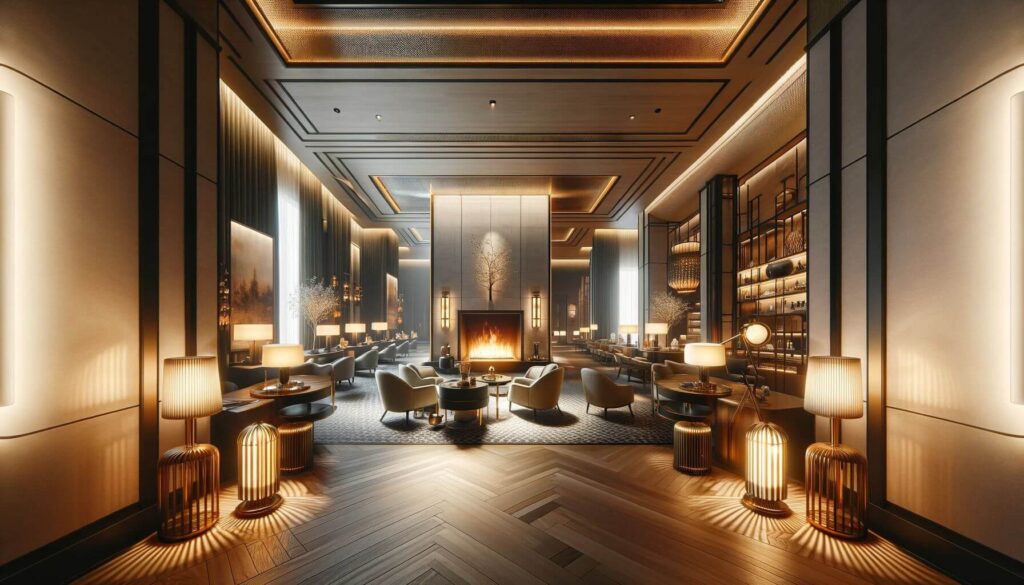
The ambiance of a hotel plays a pivotal role in shaping the guest experience, often leaving a lasting impression that goes beyond the confines of a temporary stay. In the realm of hotel design, every detail counts, and the creation of an inviting, comfortable, and memorable atmosphere is paramount. This is where the interplay of lighting and fireplace design comes into play, serving as key elements in crafting an environment that both captivates and comforts.
Lighting, with its ability to transform spaces, plays a crucial role in setting the mood and tone of a hotel. From the warm glow of a lobby to the soft illumination in a guest room, lighting can create a sense of luxury, relaxation, or even excitement. Similarly, fireplaces have long been symbols of warmth and hospitality. Their traditional role of providing heat has evolved, and they now also serve as focal points of design, adding an element of sophistication and charm.
Combining innovative lighting with artistic fireplace design opens up new possibilities in enhancing hotel ambiance. This synergy not only elevates the aesthetic appeal but also contributes to an immersive experience for guests.
It is a thoughtful dance of light and warmth that can turn ordinary spaces into extraordinary ones. In this article, we explore how the fusion of these two elements can redefine hotel environments, making them not just places to stay, but destinations to remember.
Role of Lighting in Hotel Ambiance

Psychological Impact of Lighting on Guests
Lighting plays a crucial role in influencing the psychological well-being of hotel guests. It is not just about visibility; lighting impacts mood, perception, and even emotional responses. Bright, natural light can energize and uplift spirits, ideal for lobbies and dining areas. In contrast, softer, warmer lighting induces relaxation and comfort, perfect for guest rooms and lounges. The correct balance and intensity of light can create a sense of space or intimacy, directly impacting the guest’s experience.
Lighting Techniques in Hotels
- Ambient Lighting: This is the primary source of light in a room, providing overall illumination. In hotels, ambient lighting sets the general mood of the space. Soft, evenly distributed light can create a welcoming and comfortable atmosphere, essential in areas like lobbies and rooms.
- Task Lighting: As the name suggests, task lighting is used to illuminate specific areas for activities like reading or working. In hotels, task lighting is crucial in guest rooms, business centers, and reading lounges. Proper task lighting ensures functionality without compromising on comfort.
- Accent Lighting: This type of lighting is used to highlight architectural features, artwork, or key design elements in hotels. Accent lighting draws attention to these details, enhancing the aesthetic appeal of the space. It can be used to spotlight sculptures, paintings, or even to accentuate the textures of a fireplace.
The ambiance of a hotel is shaped by each of these lighting techniques. Thus, when artfully combined, they can transform spaces, evoke emotions, and leave lasting impressions on guests. The key lies in understanding the purpose of each space and using lighting to complement its function and design.
Fireplace Aesthetics in Hotels

Historical Significance of Fireplaces
Fireplaces have long held a place of importance in communal spaces, including hotels, symbolizing warmth, hospitality, and gathering. Historically, they were central to a hotel’s lobby or common room, serving as a welcoming beacon for travelers. The warmth of a fireplace provided physical comfort, while its flickering flames offered a sense of tranquility and homeliness. This traditional role of fireplaces in creating a welcoming atmosphere continues to influence their presence in modern hotel design.
Modern Trends in Fireplace Design
In recent years, fireplace design in hotels has seen a significant transformation, aligning with contemporary aesthetic and environmental values.
- Eco-Friendly Designs: Today’s fireplaces often prioritize sustainability. Eco-friendly fireplaces, such as those using bioethanol or electric models, are becoming more popular. They offer the warmth and ambiance of traditional fireplaces but with lower emissions and a reduced environmental footprint.
- Technology-Integrated Fireplaces: Advancements in technology have led to the integration of smart features in fireplaces. Programmable settings for temperature control, LED lighting effects, and even remote-controlled operation are now common. These features enhance the functionality of fireplaces while adding to the overall guest experience.
- Art-Focused Designs: Fireplaces are increasingly being viewed as pieces of art. Designers are experimenting with unconventional shapes, materials, and sizes, turning fireplaces into focal points of interior décor. From sleek, minimalist designs to bold, sculptural pieces, fireplaces in hotels are becoming more than just functional elements; they are statement pieces that reflect a hotel’s unique character and style.
These modern trends in fireplace design reflect a blend of tradition with innovation. By adapting to contemporary needs and tastes, fireplaces continue to be an integral and evolving aspect of hotel ambiance, contributing significantly to the aesthetic and experiential quality of hotel environments.
Integration of Lighting and Fireplace Design

The integration of lighting and fireplace design in hotels is a study in creating harmony and enhancing ambiance. The right lighting can elevate a fireplace from a mere heat source to a captivating feature of interior design.
Highlighting Fireplace Designs with Lighting
Strategic lighting can accentuate the beauty and design of a fireplace, making it a standout feature in any space. For example, accent lighting can be used to highlight the texture and color of the fireplace, drawing attention to its intricate details. In contrast, ambient lighting can create a soft glow around the fireplace, enhancing its warmth and inviting appeal. The goal is to use lighting to create depth, contrast, and focus, ensuring the fireplace is seen as a key element of the room’s design.
Examples of Successful Integration
- Hotel Lobbies: In hotel lobbies, a grand fireplace can be illuminated with overhead accent lights or spotlights to create a welcoming focal point. The lighting can be adjusted for different times of the day, brighter during the day for a lively atmosphere and dimmer in the evening for a cozy ambiance.
- Hotel Rooms: In guest rooms, fireplaces often serve as a comfort element. Task lighting, such as adjustable wall sconces or floor lamps, can be positioned near the fireplace, providing guests with the perfect light to read by the fire. Ambient lighting can also be used to create a relaxing environment that complements the warmth of the fireplace.
- Dining Areas: In hotel dining areas, fireplaces can enhance the dining experience. Warm, diffused lighting can be used to create a romantic or intimate setting, with the fireplace acting as a sophisticated backdrop. Alternatively, brighter lighting can be used to highlight a modern fireplace design, adding to the restaurant’s aesthetic appeal.
The integration of lighting and fireplace design plays a critical role in defining the space and creating an inviting atmosphere. Hotels can create unique environments that resonate with guests, making their stay memorable if they thoughtfully combining these elements.
Case Studies
Let’s explore specific hotels that have excelled in integrating lighting and fireplace design, enhancing both guest experience and hotel aesthetics.
The Mountain View Lodge
Nestled in a picturesque mountainous region, The Mountain View Lodge boasts a stunning stone fireplace in its lobby. The fireplace is strategically lit with a combination of ambient and accent lighting that highlights its natural stone texture and creates a warm, welcoming environment. The lighting is programmed to change throughout the day, mimicking the natural light outside and enhancing the rustic charm of the lodge. Guests often gather around the fireplace, drawn by its inviting ambiance, making it the heart of the lodge.
The Urban Retreat Hotel
In the bustling city center, The Urban Retreat Hotel presents a modern take on the traditional fireplace. Located in the main dining area, the hotel features a sleek, linear gas fireplace surrounded by glass. The fireplace is illuminated with LED lights that change color, adding a contemporary and sophisticated touch to the dining experience. The dynamic lighting design creates an atmosphere that is both trendy and comfortable, appealing to the hotel’s cosmopolitan clientele.
The Seaside Haven
At The Seaside Haven, a luxury hotel by the coast, the integration of lighting and fireplace design is evident in its outdoor lounging area. Here, a circular fire pit serves as a centerpiece, surrounded by ambient lighting that mirrors the soft glow of the sunset. The lighting enhances the natural beauty of the fire pit, creating a serene and enchanting atmosphere where guests can relax to the sound of the waves.
Design Considerations and Challenges

Integrating lighting and fireplace designs in hotel settings involves navigating various practical considerations and challenges. Balancing aesthetic appeal with functionality, safety, and efficiency is key to successful implementation.
Practical Considerations
- Safety: The foremost consideration is safety, especially when combining electrical elements like lighting with fireplaces. Ensuring proper insulation, safe distances between light fixtures and heat sources, and adhering to fire safety regulations are essential.
- Energy Efficiency: Both lighting and fireplaces must be energy-efficient to minimize the environmental impact and reduce operational costs. Using LED lighting, energy-efficient electric fireplaces, and smart systems that adjust settings based on occupancy and time can significantly lower energy consumption.
- Space Utilization: In hotel design, space is a premium. The integration of lighting and fireplaces should not only complement the available space but also enhance it. Designers must consider the size, scale, and placement of these elements to ensure they add value without overwhelming the space.
Challenges and Solutions
- Balancing Form and Function: Achieving a perfect balance between aesthetic appeal and functionality can be challenging. Solutions involve using adaptable lighting systems and versatile fireplace designs that can serve multiple purposes.
- Technical Complexity: Integrating advanced technology in lighting and fireplace systems can be complex. Collaborating with experienced technicians and using modular, user-friendly systems can help mitigate these challenges.
- Maintaining Design Consistency: Ensuring that the lighting and fireplace designs are cohesive with the overall hotel theme requires careful planning. This can be addressed by having a clear design vision and using customizable elements that can be tailored to fit the desired aesthetic.
- Budget Constraints: High-quality lighting and fireplace installations can be costly. Solutions include phased implementations, selecting cost-effective materials, and prioritizing key areas for maximum impact.
Hotels can create safe, efficient, and aesthetically pleasing spaces that enhance the guest experience and align with operational goals if they address these considerations and challenges
Future Trends in Lighting And Fireplace Design Hotels

As we look towards the future, lighting and fireplace design in hotels are poised to be influenced by emerging technologies and evolving guest preferences. Here are some predictions for future trends:
Integration of Advanced Technologies
- Smart Lighting and Fireplace Controls: The integration of AI and IoT in lighting and fireplace systems will allow for smarter control. This could include voice-activated adjustments, motion sensor-based lighting, and fireplaces that can be controlled via smartphone apps.
- Augmented Reality (AR) and Virtual Reality (VR): These technologies might be used to create immersive experiences around fireplaces, such as virtual fires or interactive light displays that enhance the overall ambiance.
- Sustainable and Energy-Efficient Designs: As the focus on sustainability intensifies, we’ll see more eco-friendly and energy-efficient lighting and fireplace solutions. This could include solar-powered lighting and carbon-neutral fireplaces.
Evolving Design Trends
- Customizable and Modular Designs: Flexibility will be key in future designs. Modular lighting and fireplace units that can be customized to fit different spaces and design needs will become more popular.
- Biophilic Design Elements: Incorporating natural elements into design will continue to grow. This could mean integrating living greenery into fireplace designs or using natural light-inspired lighting schemes.
- Interactive and Multi-Sensory Features: Fireplaces and lighting that engage other senses like touch (through heat) and sound (with integrated sound systems) will enhance the guest experience.
- Minimalistic and Integrated Designs: Sleek, unobtrusive designs that blend seamlessly with the hotel’s architecture will become more prevalent. Fireplaces and lighting fixtures that double as art pieces will also be a significant trend.
As emerging technologies continue to evolve, they will undoubtedly shape and redefine the future of lighting and fireplace design in hotels, offering new ways to enhance guest experience through innovation, sustainability, and interactivity.
How Lighting & Fireplace Aesthetics Enhance Hotel Ambiance

The exploration of innovative lighting and fireplace design in hotels underscores the profound impact these elements have on creating a distinctive and memorable ambiance. Lighting, with its ability to set mood and highlight architectural features, and fireplaces, as symbols of warmth and comfort, together play a crucial role in defining the character of a hotel.
The integration of these elements goes beyond mere aesthetics; it’s about crafting an experience that resonates with guests, evoking feelings of luxury, comfort, and well-being. As we’ve seen, the thoughtful combination of lighting and fireplace design can transform ordinary spaces into extraordinary ones, making a hotel not just a place to stay, but a destination in itself.
For hoteliers and designers, the message is clear: consider these elements not as separate entities, but as harmonious components of a single vision. Embrace the advancements in technology and design trends, and harness their potential to create unique, inviting, and memorable environments. By doing so, hotels can not only enhance their aesthetic appeal but also elevate the overall guest experience, setting themselves apart in the competitive hospitality market.
Therefore, as the hotel industry continues to evolve, the importance of innovative lighting and fireplace design in enhancing hotel ambiance cannot be overstated. These elements should be a key consideration in hotel design, helping to create spaces that guests will love, remember, and return to.



